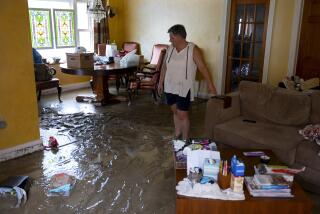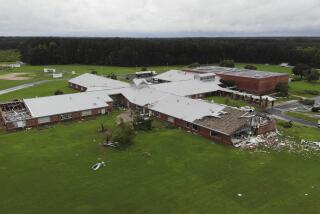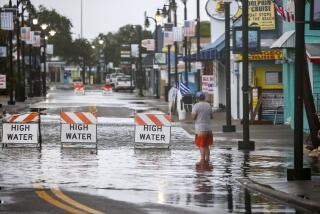‘Blizzard of ‘93’ Leaves 42 Dead as Snow, Tornadoes Rake East : Storm: Like a cold slap, gale-force ‘monster’ stuns millions. Power outages, damages are spread from Maine to Florida. Clinton calls out emergency team.
WASHINGTON — A ferocious late-winter storm billed as one of the worst of the century smashed the Eastern Seaboard on Saturday, spawning killer tornadoes in Florida, dumping record amounts of snow from the Deep South to New England and unleashing gale-force winds that forced thousands of coastal residents to evacuate their homes.
At least 42 deaths were attributed to the “Blizzard of ‘93” and more than 3 million customers were without electricity at the peak of the storm Saturday afternoon.
The result of a collision between an arctic air mass and warm, moist air from the Gulf of Mexico, the storm dished out a bizarre combination of thundershowers, lightning, sleet, daylong rain and heavy snow from South Florida to Canada.
So stunning was its fury that it was dubbed a “winter hurricane” and “monster storm” by weather reporters and forecasters.
The worst effects were felt in Florida, where scores of tornadoes struck in the north-central part of the state, killing 18 people and causing power outages affecting 2 million homes. The dead included people killed in the wreckage of mobile homes, those who suffered heart attacks while shoveling snow and homeless people who died of exposure.
Four weather-related deaths were reported each in North Carolina and New York, three in Georgia, two each in Maine, Tennessee and Pennsylvania, and one each in Alabama, Connecticut, Kentucky, Louisiana, Mississippi, South Carolina and Virginia.
Millions of others in the eastern United States suffered from the enormous power of the storm, which packed such destructive force and spread across such a large area that it rivaled the legendary “Blizzard of ‘88” that devastated the Northeast 105 years ago.
Punishing winds--above 70 m.p.h. in many places and peaking at 109 m.p.h. in the Dry Tortugas, an island chain off the southwest coast of Florida--accounted for most of the damage and power outages.
Winds, snowy runways and low visibility forced the closing of major airports in the East, stranding thousands of passengers nationwide. Airports in New York City, Washington, Baltimore, Boston, Philadelphia, Pittsburgh and Atlanta were among those expected to be shut down throughout Saturday night.
The storm disrupted some flights out of Los Angeles International Airport and other West Coast airports. Dale Harris, superintendent for operations at LAX, advised travelers to contact their airlines before coming to the airport to find out the status of scheduled flights.
Highway traffic also was halted or slowed in many states in the storm’s path. Jittery shoppers jammed grocery stores to stock up on food, and video stores reported a tidal wave of customers seeking in-home entertainment. Digging cars out of snow banks became an instant winter sport.
Reacting swiftly, President Clinton mobilized the Federal Emergency Management Agency to get in touch with officials of the hardest-hit areas and devoted much of his day to monitoring the damage caused by high winds, high water and icy roads.
“We’re trying to assess the damage and see what other resources might be brought into play,” Clinton said at a news briefing, clearly mindful of the criticism heaped on President George Bush over seeming inaction in the wake of last year’s Hurricane Andrew.
Governors of 12 states declared emergencies. Shelters were opened and National Guard units were called out in some flooded areas to assist in evacuations. Connecticut Gov. Lowell P. Weicker joined many other officials in advising residents of his state: “Stay home.”
In New York City, several bridges were closed and Central Park resembled a winter wonderland, covered with a record 10 inches of snow by late afternoon. About 1,700 snowplows tried to keep major routes clear, with limited success, and downtown streets were deserted.
“We are fighting one of the greatest winter storms in 100 years,” said New York’s Mayor David N. Dinkins.
Barbara McNaught, a meteorologist for the National Weather Service, said the storm was unusual because of extremely low barometric pressure at its center, causing extremely high winds.
McNaught said it was too soon to assess the storm’s effect, but she said the size of the affected area could make it one of the most memorable in decades.
The storm struck Florida and the Deep South before sweeping north through the Carolinas and Mid-Atlantic states, then lashing the New York area and New England states with heavy snows and high winds. Its wintry blasts were felt as far west as Louisiana.
The National Weather Service predicted that the record-breaking cold, snow and winds would continue through the night, tapering off this morning. Snowfall ranged from a few inches in Mobile, Ala., to more than three feet in the mountains of Maryland and Pennsylvania. A hard-freeze warning was issued for Central Florida, but high winds were expected to lessen the cold’s effect on citrus crops.
Warned of the storm’s arrival, many Saturday events were canceled, including the St. Patrick’s Day parade in Boston, while countless shopping malls and even the Smithsonian Institution’s museums in Washington shut their doors.
Motorists confronting blinding snow and ice-covered roads also encountered an additional problem: Many gas stations along the way were unable to pump gas because their power was knocked out by the storm.
The South
Gov. Lawton Chiles declared a state of emergency in 17 of Florida’s 67 counties and called out the National Guard in areas of heavy flooding. High winds--measured at close to 90 m.p.h.--were a nightmarish reminder of Hurricane Andrew, which hit the state six months ago.
One woman in South Florida who had lost her home in the hurricane and was living in a trailer was killed when the wind flipped it over and ripped it apart.
And tourists from the Northeast were stranded at Miami’s airport when their flights could not land in major cities in the North.
A record 15 inches of snow fell at Birmingham, Ala., with strong winds creating drifts that closed roads across the state, where 382,000 people lost power.
Georgia Gov. Zell Miller, declaring an emergency in his state, where 300,000 homes were without electricity, said: “It’s a huge mess, the roughest I have ever seen.”
Miller mobilized the National Guard and opened armories for makeshift shelters.
Atlanta’s airport was shut down and intercity bus service was halted. Atlanta was hit by howling winds and blowing snow, with wind-chill readings below zero, freezing early blooming daffodils and fruit trees. Streets in Georgia’s capital were virtually closed because drifting snow covered curbs and median strips.
In Mississippi, six inches of snow blanketed Meridian, and temperatures were plunging into the mid-teens in the Magnolia State.
Heavy snow and high winds were reported in the mountainous western areas of North Carolina and South Carolina, with more than a foot of snow at Asheville, N.C., and drifts up to five feet on Mt. Mitchell, the tallest peak in North Carolina.
About 62,000 customers were without electricity in South Carolina, and 20,000 lost power in North Carolina.
In Charleston, S.C., the Cooper River bridge was shut temporarily because of powerful winds. Rain pounded Raleigh, N.C., as the snowstorm detoured around the eastern part of the state.
Blizzards struck eastern Kentucky, with up to two feet of snow expected in some parts, and huge drifts blocked major roads. Wind-chill readings down to 20 below zero were forecast. In Tennessee, a record 21 inches of snow hit Chattanooga and power outages were reported in the mountainous eastern part of the state.
Weather forecasters said winds up to 60 m.p.h. and temperatures below 10 degrees would make it feel as if it were 50 degrees below zero. Lewisburg reported 14 inches of snow.
Central States
Snow squalls wrapping around the back of the storm caused 250 flights to be canceled at Chicago’s O’Hare International Airport, and a 40-car pileup snarled traffic near Detroit. There were no serious injuries.
On the western fringe of the super storm, Cleveland and the northeastern part of Ohio had a foot of snow by late Saturday. Even in this snow-belt city, accustomed to winter’s fury, shoppers flocked to grocery stores to stock up before the storm hit.
Mid-Atlantic
Airports in Washington, Baltimore and Philadelphia were closed because of high winds and snow-covered runways, stranding thousands of passengers.
In Virginia, statewide Democratic Party caucuses were canceled because of heavy rain and snow. Roanoke reported 15 inches of snow, and heavy rains in the central and southeastern parts of the state threatened flooding and beach erosion.
In Maryland, 43,500 customers lost power. Residents of Dewey Beach on the Delaware coast were ordered to move inland.
In New Jersey, coastal residents were evacuated in some areas as some streets flooded at high tide, and Gov. James J. Florio declared an emergency. Cherry Hill, N.J., reported nearly 12 inches of snow.
In a month that averages only eight inches of snow, the Pittsburgh, Pa., area was paralyzed.
Thousands were without power as metropolitan Pittsburgh’s 2 million citizens hid from wind-chill factors of minus 30 degrees.
By late Saturday, Pittsburgh recorded 23 inches of snow, a record for a 24-hour period. Pittsburgh Airport was shut down Saturday afternoon and was not expected to reopen until 8 p.m. EST today.
All across Western Pennsylvania, winds gusted to 40 m.p.h. for hours, whipping a hurricane of snow into five-foot drifts, obliterating the work of snowplows in minutes and creating a white-out that reduced visibility to one-sixteenth of a mile.
With three feet of snow piling up in the mountains east of Pittsburgh and the state capital of Harrisburg buried under 18 inches of snow, Gov. Robert P. Casey declared a state of emergency.
The Pennsylvania Turnpike--heralded as the All-Weather Highway--was closed to all traffic, as were all interstates and the state’s other main roads. Pittsburgh’s annual St. Patrick’s Day parade, one of the largest in the country, was one of the few events Saturday that was not canceled.
The Northeast
In New York, Manhattan was virtually deserted, and several streets were closed as high winds, measuring 50 m.p.h. and above, blew out skyscraper windows.
“If you don’t have to go out, stay home,” Mayor Dinkins advised.
John F. Kennedy International Airport, which handles most international traffic, was closed indefinitely, although La Guardia and Newark terminals may open today.
Three bridges across the East River were shut down because of high winds, and parts of the George Washington Bridge and the Verrazano Bridge, leading west, also were closed. Winds up to 60 m.p.h. were recorded on Long Island beaches.
Forty emergency shelters were opened in Connecticut for families whose electricity was knocked out. Rhode Island also declared a state of emergency and asked coastal residents to evacuate.
Massachusetts officials feared damage to waterfront residences by wind-whipped waves up to 20 feet high. The Boston airport was closed, and customers waited for hours in food stores as forecasters predicted two feet of snow, or more, in the Boston area.
In Maine, schools and fire stations were opened as shelters near the Atlantic Ocean in the southern part of the state.
Times staff writers Sara Fritz in Hartford, Conn., David Lauter and John J. Goldman in New York, David G. Savage in Melbourne, Fla., Tina Daunt in Los Angeles, correspondents Mike Clary in Miami and Bill Steigerwald in Pittsburgh and researcher Edith Stanley in Atlanta contributed to this story.
OUT OF ACTION: Many sports events are postponed by the massive storm. C1
1. North-Central Florida: Scores of tornadoes rake area and cut power to 2 million homes.
2. Mid-Atlantic States: Airports in major cities are closed, stranding thousands. Some coastal residents are evacuated as streets flood.
3. Washington: President Clinton mobilizes the Federal Emergency Management Agency.
4. New York City: Central Park is covered with a record 10 inches of snow.
A Path of Destruction
Here are some facts and figures on the blizzard that struck the East Coast, bringing record snow, tornadoes and winds over 100 m.p.h.:
MISSISSIPPI: Up to 6 inches of snow has laft about 6,500 people without power.
ALABAMA: A record 15 inches of snow has socked the Birmingham area. Wind gusts of up to 45 m.p.h. have whipped the snow into drifts up to 6 feet deep. Approximately 382,000 were without power.
FLORIDA: Ankle-deep snow plagued the Panhandle, and 50 tornadoes were reported. Wind gusts of up to 109 m.p.h. hammered the Dry Tortugas. At least 18 people are dead, and nearly 2 million were without power.
GEORGIA: Northern mountains have been hit by 12 inches of snow, and at least 300,000 homes were without power.
SOUTH CAROLINA: Ten inches of snow has fallen in the northern mountains. More than 62,000 people lost electrical power as utility crews battled wind gusts of up to 70 m.p.h.
NORTH CAROLINA: Up to 12 inches of snow has fallen, and emergency shelters have opened in seven counties. One traffic death is blamed on snow-covered roads. Power outages have affected 20,000 people. Hurricane-force winds and flooding are possible along the coast.
TENNESSEE: An unknown number of motorists have been stranded by up to 21 inches of snow.
VIRGINIA: Up to 15 inches of snow has fallen in the Roanoke area, while rain drenched the central and southeast parts of state.
KENTUCKY: Blizzard conditions were reported in the east, with snowfall expected to reach up to 24 inches.
WEST VIRGINIA: Up to 14 inches of snow was reported. Wind chills could dip to 50 below.
OHIO: Up to 12 inches of snow has fallen, whipped by winds of up to 40 m.p.h.
MARYLAND: Utilities reported 43,500 people were without power.
DISTRICT OF COLUMBIA: National and Dulles airports were closed, as were the Smithsonian Institution museums.
DELAWARE: Dewey Beach mayor has ordered the evacuation of all elderly, handicapped and oceanfront residents.
PENNSYLVANIA: State has been hit by up to 23 inches of snow, closing airports in Philadelphia, Harrisburg and Pittsburgh and stranding thousands.
NEW JERSEY: Up to 12 inches of snow has been reported, and the midday high tide flooded streets in communities have set up shelters for evacuees.
NEW YORK: Ten-inch snowfalls and winds of up to 50 m.p.h. have been reported. LaGuardia and Kennedy airports were closed.
CONNECTICUT: A state of emergency has been declared.
RHODE ISLAND: A state of emergency has been declared, and coastal residents were asked to evacuate.
MASSACHUSETTS: Coastal towns have activated their emergency management network.
MAINE: Shelters have opened near shore areas, and some coastal residents have been encouraged to move out of their homes.
More to Read
Sign up for Essential California
The most important California stories and recommendations in your inbox every morning.
You may occasionally receive promotional content from the Los Angeles Times.









